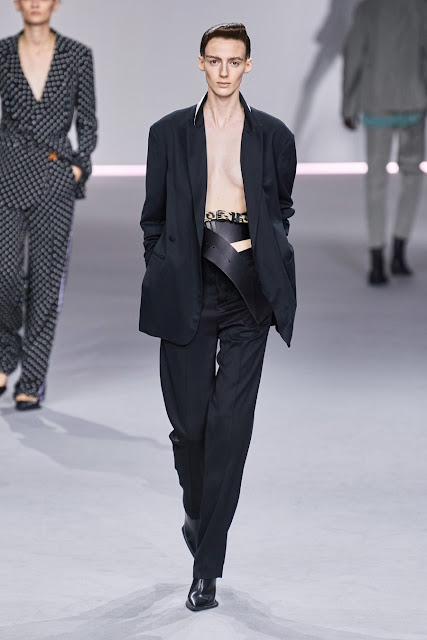Haider Ackermann. Spring 2020 RTW - Paris Fashion Week.
Haider Ackermann delivers his fixed arrays of the feminine wearing masculine styles, that as noted form his Fall 2019 Collection. He wanted to ensure that the androgynous transversed in one direction, towards the female. To which he remarked with his last Paris showing “It's not unisex, it's about borrowing”, in which he further went on to comment on the thrill of seeing a female in your wardrobe styles; the morning after. However, for his Spring 2020 ensembles, he has broken it down more into a modernist and structured concept, rather than a conceptual idealism from previous collections. This could be indicative of a designer beginning to draw back to study the cleaner forms, maintaining the basic and minimalistic as away of discerning a more open perspective. Which is important, rather than the obvious, allow the spectators or audience to study the aesthetics beyond a said theme.
But, ego and the designer are both a blessing and curse, to which with Ackermann has not set it too far back into a minimalist pose, rather he has balanced the first half of the collection as a cleaner and more refrained styles, allowing the middle and closing looks to be the more expressive of his inclinations; and sex is on Ackermann's carte du jour. An assertive trend forming around the Spring 2020 showings, is an underlying expression. The bareness and revealing nature of some of the styles on offer has set in motion of a more skin and less fabric. So, the seriousness of Ackermann's latest Spring collection holds true, it is not as relaxed as portrayed. The sexual intensity (or tension) remains.
The plunging v neck lines, open blazers, satin, silks leather and beautiful fine wools. Neatly draped and fitted onto the models. Ackermann is a master at tailoring a neatness into his styles, with materials that notoriously can bunch up, the whole collection feels smooth and crisp, but without the delicateness. His Spring 2020 collection shows it's trueness as the Ready-to-Wear formation, with some of the men's styles offering a slouchy coolness, whilst the women's is more nonchalant and detached.
Although not as extravagant as previous collections, Ackermann is maintaining the said themes in lieu of the differentials of women and men (at least materialistically), although he has attached the bridge of male styles onto females, it seems to be, as mentioned earlier, crossing only one way. Which is expected, however it may over time, morph into a more homogeneous array.
Sometimes we relish in distinction.











Comments
Post a Comment